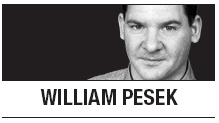As economists scour the earth for clues on which country is headed for a crash next, should they be worrying about South Korea (KOSPI)?
An oddly timed question, perhaps, given Korea’s resilience compared with its Asian compatriots. Even if the region is not on the verge of a 1997-style

meltdown, scary drops in the Indian rupee, Indonesian rupiah, Malaysian ringgit and Thai stocks are fueling anxieties almost everywhere. Korea is a rare exception: It has a current-account surplus equal to 4.9 percent of gross domestic product, a well-performing won that the International Monetary Fund says is undervalued, and expectations for 4 percent growth in 2014.
In fact, investors who bet against Korea over the last 15 years haven’t done very well. In 2008, some wagered that Korea was the national equivalent of Bear Stearns Co. ― that, like an investment bank, a bubble in negativity would cause a run on the economy. Two years later, with Europe in a tailspin, short-sellers gambled that Korea would be the next Iceland. Korea confounded both sets of naysayers.
What worries me, though, is that officials in Seoul seem too busy popping champagne corks to address another crisis, this one domestic and of their own making: a midlife one.
Korea surely deserves a pat on the back for overhauling an economy that crashed spectacularly in 1997. Efforts to upgrade the banking system and bolster its defenses ― such as reducing short-term external debt and building up foreign-exchange reserves to a record $330 billion ― are paying off. As strategist Timothy Moe at Goldman Sachs Group Inc. in Hong Kong wrote in a June 17 note, worries related to the Federal Reserve altering its quantitative-easing program “are not likely to impact Korean equities as much” as the rest of Asia.
But Korea’s real challenge is one of reinvention: to find a new economic model to replace its previous dependence on exports. For years, Koreans buzzed about catching up to the developed world. Now that they largely have, the question is what comes next. If Korea is having the economic equivalent of a midlife crisis, my conversations in Seoul this week suggest it is moving too slowly to address it.
President Park Geun Hye has said she wants to transform Korea into a “creative economy.” That sounds like just what a nation sandwiched uncomfortably between high-tech Japan and low-cost China needs. If conservative Korea could become a mecca of innovation and risk-taking, scrappy startups and venture-capital buzz would in theory create loads of high-paying jobs and increase competitiveness.
Yet try finding a Korean who truly understands how Park intends to shake up Korea Inc. in practice. “It’s all very vague, and the definitions keep shifting,” says Lee Jin-Woo, head of research at NH Investment & Futures Co. “The problem is, no one knows what the president means or what she is doing.”
Park can’t just order her people to be more entrepreneurial using slogans and photo opportunities with Facebook Inc. founder Mark Zuckerberg, who visited Seoul in June. That hasn’t worked for Singapore. A real transformation requires clear goals and specific action plans. One senior government official told me that Park’s “creative economy” campaign is looking a lot like Japanese Prime Minister Shinzo Abe’s efforts to boost confidence without implementing a single structural reform. It’s hard to dispute the comparison.
Chaebol reform ― or lack thereof ― raises another warning flag. Park won last year’s election pledging to rein in the family-run conglomerates that suck up all the oxygen in Korea’s economy. Reducing their role is central to making Korea more dynamic, but Park’s predecessor, Lee Myung-Bak, squandered his term broadening it ― five years that Korea didn’t have to waste.
A vibrant stable of smaller companies would also make Korea less export-dependent. The chaebol are largely focused on shipping goods overseas, and their outsize role impedes the creation of a thriving services sector. There’s far more promise in expanding tourism, financial services, science, health care and education than loading container ships.
But this week in Seoul came two ominous indications that the chaebol remain supreme. Park met with the tycoons she is supposedly working to sideline and asked them to increase investment to hasten economic growth. In return, Park promised she would prevent regulations from obstructing their business activities. Well played, tycoons!
Park also announced that the government had scrapped a five-year-old proposal to sell Korea Development Bank, a signal that she plans to use the nation’s biggest policy lender to channel more funds to companies. You have to wonder if Korea plans to follow the China banking model, which is now shackled with bad debts run up by indiscriminate lending to favored enterprises at the government’s behest.
For the record, I don’t think Korea is headed for its own lost decade. Koreans have proved time and time again that doubting their tenacity is a sucker’s bet. But I heard the topic come up too often in Seoul to ignore the risk. Korea has come much too far to grow complacent now; this is when it needs to act most boldly. Park must work faster to put some flesh on her ideas. In the meantime, she should resist the urge to pop champagne corks over a couple of “likes” from the likes of Facebook and Goldman Sachs.
By William Pesek
William Pesek is a Bloomberg View columnist. ― Ed. (Bloomberg)





![[Exclusive] Hyundai Mobis eyes closer ties with BYD](http://res.heraldm.com/phpwas/restmb_idxmake.php?idx=644&simg=/content/image/2024/11/25/20241125050044_0.jpg)

![[Herald Review] 'Gangnam B-Side' combines social realism with masterful suspense, performance](http://res.heraldm.com/phpwas/restmb_idxmake.php?idx=644&simg=/content/image/2024/11/25/20241125050072_0.jpg)
